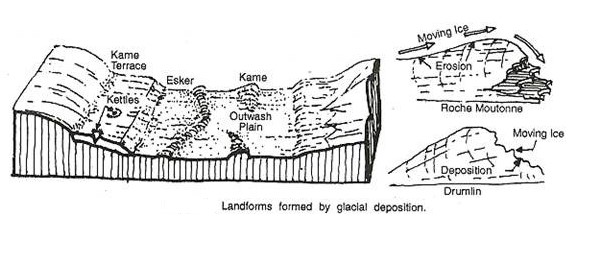-
24 Jan 2024
GS Paper 1
Geography
Day 57: Discuss the diverse depositional landforms found in glacial valleys. (150 words)
- Start the answer with a discussion that sets a context for the question.
- Discuss the diverse depositional landforms found in glacial valleys
- Also, explain these landforms with the help of diagrams.
- Conclude suitably.
Introduction
Glacial valleys are formed by the movement of glaciers, massive bodies of ice that shape the landscape through processes like erosion and deposition. The depositional landforms found in glacial valleys are diverse and showcase the dynamic nature of glacial activity.
Body
Formation of Glacial Valleys: Glacial valleys are carved out by the erosive action of glaciers as they move downhill. The glaciers erode the landscape through processes like plucking and abrasion, creating U-shaped valleys with steep sides.
- Depositional Landforms Found in Glacial Valleys:
- Moraines:
- These are accumulations of unconsolidated debris, including rocks, sediment, and till, carried and deposited by the glacier.
- There are different types of moraines, such as lateral moraines, medial moraines, and terminal moraines.
- Drumlins:
- Drumlins are elongated, tear-shaped hills formed by the deposition of glacial till.
- These features indicate the direction of ice flow and are typically found in groups called drumlin fields.
- Eskers:
- Eskers are long, winding ridges of gravel and sand that were deposited by meltwater streams flowing within or beneath glaciers.
- These sinuous landforms often extend for several kilometers and provide evidence of the subglacial drainage system.
- Kettles and Kettle Holes:
- Kettles are depressions in the glacial landscape formed when a block of ice becomes detached from the retreating glacier, and the surrounding sediments eventually fill the hole.
- Kettle holes are smaller, often circular depressions found in glacial outwash plains.
- Both features are a testament to the melting and recession of glaciers.
- Outwash Plains:
- Outwash plains are extensive flat or gently sloping areas composed of sand and gravel deposited by meltwater streams as glaciers retreat.
- Kames:
- Kames are irregular mounds of sand and gravel deposited by meltwater streams on the glacier's surface or within crevasses.
- These landforms vary in size and shape and are typically found in association with moraines.
- Moraines:
Conclusion
The diverse depositional landforms found in glacial valleys are the result of intricate interactions between glaciers and the surrounding landscape. Moraines, drumlins, eskers, kettles, outwash plains, and kames collectively paint a vivid picture of the dynamic processes shaping Earth's surface during past glaciations.





